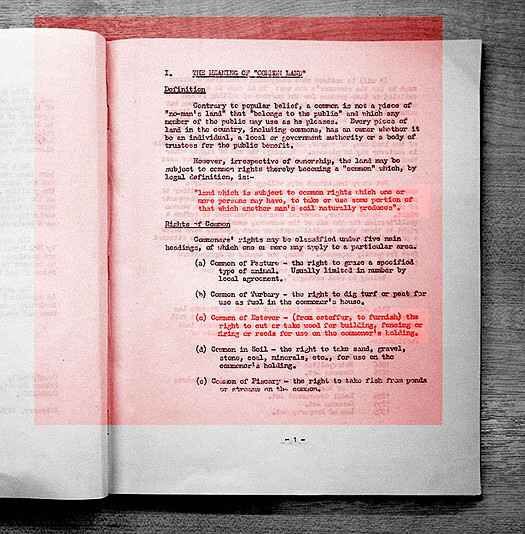What I propose, therefore, is very simple: it is nothing more than to think what we are doing.
—Hannah Arendt, The Human Condition1
1. Life Always Escapes2
One way of addressing the question of how to live together is through what we may or may not have in common. Thinking about the common and the in-common, hence, becomes a way of asking how we might find ways of building and sustaining social relations, not through economic transactions, but by establishing relationships to ownership and context in everyday life, through action, labor, and in duration. This text looks to the emergence and use of common land in the context of the British Commons as an entry point for viewing commoning and being in common as a possible, general condition.
The Commons at first appear like an oddity: flat and rather nondescript expanses of grass and trees, urban parks that are not tended too well, with some occasional flowers or beds of ornamental plants. The Commons, however, are not local gardens; they are Common Land—land to which certain customary rights have been attached. The British Commons can be taken as a model of social invention, for sharing resources, ownership, and authority. They are not based on some utopian, free-for-all fantasy of everlasting communal happiness, but are a radical, self-organized, profoundly democratic type of governance. And in this sense the Commons are both physical places—scattered bits of land throughout the map—and a site of struggle and revolutionary thinking, a movement against the privatization of resources and means of subsistence, clusters of an enormous political imaginary directed towards economic and political equity.
To hear similar sentiments invoked by a Leveller in 1649 can provide some comfort against the solitude of asking very similar questions today.3 Another motivation for reviving and acting from a discourse that may have originated over 400 years ago is best explained by Avery Gordon in her conversation with Natascha Sadr Haghighian, in which she quotes Christopher Hill:
There was, however, another revolution which never happened, though from time to time it threatened. This might have established communal property, a far wider democracy in political and legal institutions, might have disestablished the state church and rejected the protestant ethic.4
Subsequently, Gordon shows not only that the questions and demands surrounding common property never disappeared—and continue today as important movements around the globe—but also warns of the extent to which “radical or subjugated knowledges tend to be re-appropriated from their guiding motivations towards other ends—like for corporate profitability.”
2… . to take or use some portion of that which another man’s soil naturally produces
Commons are an exception within present systems of legal ownership that rely fully on private property. A Common is a piece of land that may be owned by one or several persons, but over which other people can exercise certain traditional rights “to take or use some portion of that which another man’s soil naturally produces,” indefinitely.5 Common land is not public (nor does it, like most parks and open spaces in London or other British cities, necessarily belong to the Crown or aristocracy) and has quite a unique jurisdictional status based on the rights of use: it is land to be used “in common.” Commons therefore cannot be developed or built upon by the owner(s), nor can they be used speculatively or sold without those rights.
The rights of common were already in existence since time immemorial, meaning they were present in Roman law, but in the UK it was King John who formally established them in the early thirteenth century. These granted ownership of the land to the “Lord of the Manor,” but ensured some basic rights of subsistence for his landless subjects (“commoners”). This is where the relationship between the House of Commons and the House of Lords is established. By extension, the term “commons” has come to be applied to other resources which a community has rights of access to: Commons are a subset of public goods, specifically meaning a public good which is not finite, as responsibly used land can always be a resource and a means of survival. Today Commons still exist in England, Scotland, and Wales, although their extent is much reduced from the millions of acres that existed prior to the seventeenth century and the “enclosures”—but they also appear in varying forms in the rest of Europe as quaint customary rights to pick mushrooms and the like, and have strongly informed the important social movements of the landless in Brazil, Mexico, South Africa, and India.


The social organization that provides for Commons still relies on private property, or what used to belong to the Lords of the Manor. In a feudal system this was complemented by common land, which, while still being private, was not exclusively so. By fulfilling the role of a basic provision, common land therefore opposed the right of necessity to private property. Through common and customary rights, the poor, the landless, the commoners were able to appropriate the ambiguous aspects of ownership in order to satisfy their most basic needs. Commoners could consider themselves entitled to the “gifts of nature,” as their legitimate property: it is by picking, grazing, gathering, and collecting that land is cared for, managed, and maintained in a certain sustainable order. Waste produced by the Common, in the form of fuel, food, and material, constitutes a purely accidental aspect of property. Due to its insignificance in terms of both value and labor, it is not considered to be part of the land owner’s production, and yet it is what makes commoners of those without land.
As such, the Commons provide a model for living together and sharing resources which precedes historically most democratic systems and yet is substantially more progressive—in terms of social inclusion—than most. The value and interest of the Commons is twofold: to offer other options than those based on accumulation of family wealth, and also to promote a sustainable relationship to resources based on the right of necessity. Private property as we know it now is substantially different from what it was a few hundred years ago when it entailed quite complex simultaneous relationships. It wasn’t only those without land that were left out of the process—present-day Commoners—but also the possibility of sharing ownership in ways other than kinship, with communities of choice rather than of fate. Furthermore, what is still missing is a particular way to understand relationships to resources—and more specifically to land—as active, continuous, and embedded in forms of work that need to be, by default, sustainable.
Commoners first of all respect the law of the land as opposed to the law of the sovereign; their rights are embedded in a particular ecology of local farming and the prudent management or conservation of resources.6 As Peter Linebaugh explains in The Magna Carta Manifesto:
… commoning is embedded in a labor process; it inheres in a particular praxis of field, upland, forest, marsh, coast. Common rights are entered into by labor. Third, commoning is collective. Fourth, being independent of the state, commoning is independent also of the temporality of the law and state. Magna Carta and the Charter of the Forests did not list rights, it granted perpetuities. It goes deep into human history. 7
3. Over the Fence
belong: 1340, “to go along with, relate to,” from be- intensive prefix, + O.E. langian “pertain to, to go along with.” Sense of “to be the property of” first recorded 1393. Replaced earlier O.E. gelang, with completive prefix ge-. First record of belongings “goods, effects,” is from 1817.8
The act of transferring resources from the commons to purely private ownership is known as the enclosures, or Inclosure. In 1536, Henry VIII had dissolved the monasteries and their attendant commons in a massive act of state-sponsored privatization that allowed the rising class—the gentry—to start claiming land as their own by means of the enclosures. This tendency became officially endorsed through the Inclosure Acts, a series of private acts of Parliament from about 1700 to 1850, which literally enclosed—with walls, fences, and hedges—large areas of Common, especially arable and haymeadow land and the better pasture lands. While the majority of the British landscape was already divided between Lords of the Manor and large landowners, loss of access to Commons was compensated with small parcels of individually owned land being given to some commoners. This vast redistribution and transformation of the landscape was then sealed with the first precise surveys and maps of the territory. The Inclosures established English private property and, for the first time in its history, turned land into a commodity. However, this did not happen without a struggle.
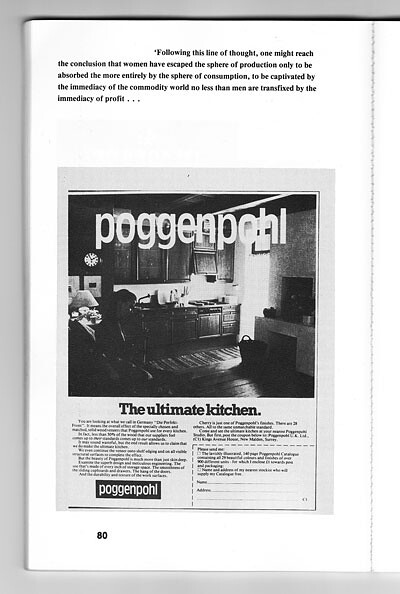

It could be argued that one of the consequences of this enormous process of privatization of land was the emergence of a new type of poverty and the rise of pauperism (of the destitutes), inasmuch as the poor, from this point in history, not only do not own any land, but neither do they have rights to use land—not even for their own survival. The transformation takes place through lines being traced on the ground and on paper, walls and fences being built, exchange values being set, and the total reframing of landscape; but this process is also one that redefines private property.
The Levellers, the radical English egalitarian political movement, attempted to reform the rising social order by levelling rights—demanding equality in property rights as well as in political rights. In 1649, during the enclosure riots, they proposed that each one is the owner of his own person, and, by extension, of the means and fruits of his labor, and that this is the condition for freedom and should be the basis of the constitution. The great social and philosophical argument around the nature of personal and private property takes place throughout Europe in the seventeenth century, and continues over the next two hundred years; it begins to trace new divisions.
“The first man who, having fenced in a piece of land, said ‘This is mine,’ and found people naïve enough to believe him, that man was the true founder of civil society,” declared Rousseau in 1754 in his Discourse on the Origins of Inequality.9 However, the French Revolution uses private property in its constitution as the very foundation of individual liberty. By the eighteenth century, surrounded by fenced-off land, Proudhon and the French socialists of the time consider private property to be illegal: “property is theft!” Marx however manages to historicize and therefore relativize the concept by defining it as a necessary mode of relations to a stage in the development of productive forces.10 Meanwhile, land is taken away from those who used it most—their civil liberties ignored or erased—and placed out of sight.
4. Captivated by the Immediacy of the Commodity
The gradual process of subtracting land from the Commons manifests itself in how the land appears afterwards, how it is represented, how this image of land is then distributed, and how a new order becomes documented—on maps, on postcards, in the landscape. The resulting images manifest another condition of the Commons’ visibility, which is their mode of display. Display has a lot to do with how boundaries are traced, how things are classified and organized; being hierarchical, classification often represses what is included and what is not, what is counted, what is valuable. The consignment of land towards the production of surplus value requires such a process of commodification.
It is through modes of display, that regimes of all sorts reveal the truths they mean to conceal.
—Peter Wollen11
Things need to be considered not just in terms of what appears intrinsic to them as objects, but also in how they appear, what they display, and how they define their horizons of possibility: it is under these conditions that systems of value take shape, ideologies are revealed, politics enacted, and aesthetics expressed. Mary Anne Staniszewski’s The Power of Display is notable for having played a critical role in integrating exhibition-making within a larger discourse.12 The book attempts to unravel the hidden complicity between museum and department store strategies of display through the rich history of conflicting ideologies behind the seemingly neutral whiteness of gallery spaces. But as she points out, the same display techniques are also at play in television, entertainment, information, and beyond, extending to determine how things appear in the world and in the environment. And it is through the development of shared concepts of “public” or “citizen” that these techniques are produced by viewers and institutional structures alike, affecting the meaning of things and shaping our understanding of culture.
Two images from The Power of Display come to mind as being relevant to the process of thinking through the Commons. They are somewhat banal images, but are striking in their lack of specific quality, primarily because of their similarity. They show how, due to a similar set of basic criteria, the presentation of objects assumes something like a standard form—one that allows us to find what we are looking for in a store or know what to look at in a museum. The museum exhibition in the photograph is composed of independent freestanding objects, each displaying distinct types of materials. Even the walls are freestanding exhibition mini-walls used for paintings (or at least framed things), while the cabinets are used for books and prints. Each kind of furniture has its own specific function, each with its own particular height, material, size. How many years did it take to develop these as ideal forms of display? The walls carry strange flower arrangements, foliage decorations; in the room there are many plants—not domestic ones, but plants that look more suited to expensive hotels.
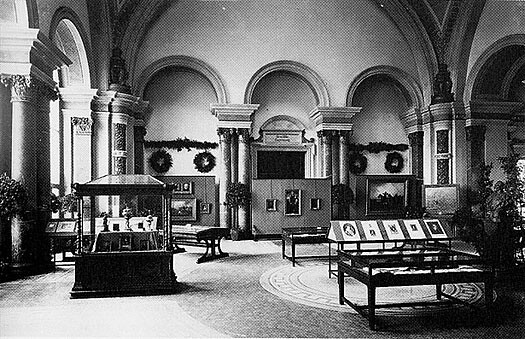

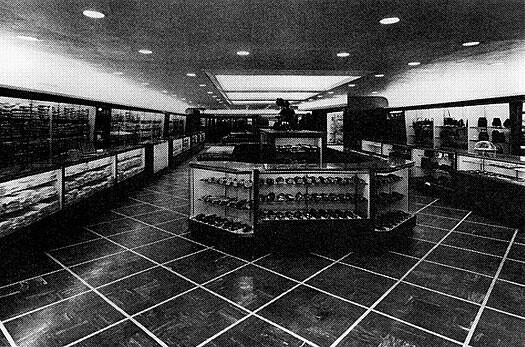

The department store display is also furniture—a single, enormous piece of furniture built right into the room. The objects placed on display are more numerous, but different parts of the furniture again offer various positions—vertical or horizontal, above eye-level or below, flat or deep—and are used for different types of objects, with less space between them, and a lot of glass. Objects are beyond reach, so that one needs to ask in order to handle anything; however, seeing something in a store equates to holding it in your hands and being able to feel it, turn it, analyze it. These are objects to possess.
Both photographs, by capturing in mid-distance what were considered at the time to be “modern” interiors, are actually surveying the measures taken to place objects on display, and therefore also the tremendous work entailed in doing so. What the displays show is the elegant construction of the autonomy and commodification of art objects, and its complicity with the logic of consumerism. They document manifestations of a shift in understanding and in the staging of a relationship to an environment by way of its potential means of occupation. They present us with the process of producing meaning and value: a process of commodification that is apparent not only through its objects, but also in their placement in a context, an environment. And in order for the objects to be bought, they need to be broken up and isolated from their environment, and it is precisely this process that takes place in determining how land is to be used, exchanged, and understood.
5. Common Images
I recently produced a work that addresses the Commons in relationship to generosity, with its conflicting ambiguities and politics.13 In the process of collecting different material and sources, I sought out images to associate with the social model of the Commons, and gathered a number of postcards of the British Commons. All of them appear to have been produced in the period between 1900 and 1920, and most were bought and used in those years and subsequently kept until they entered the antique postcard market.14
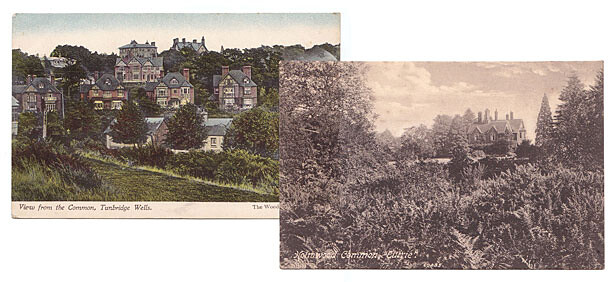

Intense work went into producing these images: the careful recoloring, the elegant typesetting, the framing, how they relate to paper, format. The text, sometimes in contrasting colors, is laconic and descriptive, listing the depicted Commons’ names. Each postcard apparently documents a place, captures it, objectively titling it. They are so matter-of-fact, and yet the images are not. Recoloring entails an act of repetition: there was color there before, yet more had to be added, and then it was done again—suggesting that the first time wasn’t good enough, or that the original color was lost or damaged. But what all these layers of work seem to give the postcards in the end is in fact a painterly quality—through these treatments, the images enter into a relationship with English landscape painting, and in doing so, they inscribe the Commons in that history.
For my purposes, the postcards provide a particular documentation of a phenomenon, made across a country; I could not find any from later years, which seems to indicate that they are also a document of a transition, of a necessary historical project, however unknown it may be to us. The places they depict are familiar in their banality—at least for someone who lives in the UK—and are therefore recognizable, specific. And yet they seem like frozen moments in a walk, taken while approaching a change in the landscape or coming upon a particularly fine view, not unlike the way English parks and landscapes were actually constructed as choreographed walks. Though they are also photographs that have been taken on specific days and in places I might know, they have undergone such a process of transformation as to become dreamlike in their representation. These landscapes have been imperceptibly, but thoroughly, altered. What they depict is already something lost, but without indicating what that might be. And in this way, they obscure what they are really a document of.
There is something willed into existence through this series of postcards, and it is a hint of what Commons were imagined to be—how they were projected into the future to be read—just as much as what they actually stood for a century ago; the postcards are part of a project.
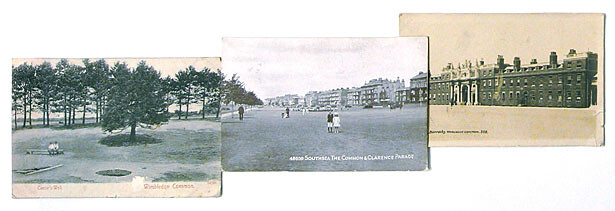

6. Futility and Other Value-Burning
(c) Common of Estover (from estoffer, to furnish) the right to cut or take wood for building, fencing or firing or reeds for use in the commoner’s holding.15
Estoffer is a French verb, which has been used since the twelfth century to mean “to augment, to stuff, to pad,” which is done by way of using estoffe (cloth or fabric) to make something finished, comfortable, ready to be occupied. By extension, estoffer also means “to fit with everything required, either for utility or for ornament.”16 The term suggests a relationship between what is added and what is necessary, between what appears to be external and ornamental and that which is at the same time necessary for life—a kind of extra-ordinary. It is the padding that touches the body and completes an object or space by making it inhabitable.
The right of estover is one of the surviving rights of common still active in the UK. Estover is the right to take timber, brushwood, bracken, etc., from commons for use in building, repairing fences, or as fuel—to help oneself to a resource produced by a space that is not one’s own. While this resource could possibly have a commercial value as such, its exchange price is disregarded in favor of its subsistence worth.
In nineteenth-century Germany, the right to gather fallen wood was gradually eliminated, and the theft of wood was punished with increasing severity. Karl Marx published a series of debates on the issue in 1842, which began to articulate his definitions of property and social justice:
In the case of fallen wood, on the contrary, nothing has been separated from property. It is only what has already been separated from property that is being separated from it. The wood thief pronounces on his own authority a sentence on property. The gatherer of fallen wood only carries out a sentence already pronounced by the very nature of the property, for the owner possesses only the tree, but the tree no longer possesses the branches that have fallen from it. The gathering of fallen wood and the theft of wood are therefore essentially different things.17
Behind the arguments on the theft of wood lies the distinction between private and public, and its application to the right of property. Marx finally unlocks the ambiguities of ownership with the magic key of “surplus value,” which takes the shape of a tree branch fallen to the ground—no longer belonging to the tree, nor to the owner of the land on which it grows—waiting to be picked up and used. Surplus value explains the relative worth and malleability in the exchange of labor or objects (an hour of my time is not necessarily worth an hour of yours, depending on the situation and demand), and locates precisely where the possibility for exploitation begins.
In reducing or almost eliminating commons, the enclosures did not erase the land, but rather put it away, moved it out of bounds, rendered inaccessible what the land offered in terms of survival, subsistence, surplus. In deleting the rights of common—and any flexible notions of property and sharing of resources they offer—the process of enclosure effectively liberates surplus value by enclosing labor.
7. Obsolete Ideas for Promulgation
We are back to a series of postcards of Commons from the beginning of the twentieth century. These postcards are about something that is not there—they depict an absence. The Commons portrayed at the beginning of the twentieth century are empty but for a few contemplative figures, quietly sitting or walking as if in a garden. People engaged in exercising their rights of common are nowhere to be seen, which is to say that Commoners themselves are absent, as are their animals, activities, work. What has been erased in these postcards is a basic provision for the poor, perhaps on account of its being considered superfluous—an idea that in turn obscures the need for social responsibility. Perhaps this corresponds to the rise of the welfare state, and its promises to provide for people’s necessities—a shift that flattens citizens into categories of need, a means of providing for people to preempt the occupation of land that does not belong to them. Missing from these images is a specific relationship to land and territory as a landscape of work—one that is entered through labor.
In what it does not show, this collection of postcards manifests a shift—an uneasy transition to a commodified landscape that can be encountered by way of display. Long after the enclosures, but soon after the redefinition of property and its rights, such images effectively participate in the formation of social order by means of omission. They document the Commons’ shift from landscapes of work into those of parks, English gardens, landscapes of leisure. Naturalistic effects usher the undoing of Commons into being sites of natural beauty, reconstructed to present the illusion of being untouched, as a return to an original moment at its most authentic—before occupation, before use and its signs, before tools, farming, animals. The promenade can thus take place in solitary, peaceful contemplation, in the landscape of English painting, in carefully composed parks that serve as backdrops punctuated by staged vistas and agreeable perspectives. In documenting this shift, images of the Commons participate in the consignment of the land to the public imaginary.
Sean Snyder said, “Architecture is not politics. A photograph of a space is not politics, but it can however generate readings.”18 Contrary to popular belief—especially in the worlds of art and architecture—forms of common space or social space are not actually nonexistent, and are therefore not in constant need of invention. They have, however, been obscured from view in order to be appropriated. This happens in overt ways—by closing spaces off, building walls, gates, and fences, and investing them with authority—but also more subtly, in ways that are more difficult to identify and question. In spaces dedicated to the exercise of alternative democracy and self-governance, for example, the actual practice of these forms is obscured to the point where it appears as both intrusive and absurd within the scope of what is deemed public. However, the possibility for such commons to reappear in the space of everyday life—within the usable, the surveyable, the accountable, and the manageable—is not without struggle.


Hannah Arendt, The Human Condition (Chicago: University of Chicago Press, 1958), 5.
“Life always escapes or exceeds the powers that work so hard to contain it.” This essay began from the installation Life Always Escapes commissioned by Wysing Arts Centre, for “Generosity is the New Political,” running from September to November 2009, supported by Arts Council England and Henry Moore Foundation.
See Gerrard Winstanley, “A Declaration from the Poor oppressed People of England,” →.
Christopher Hill, The World Turned Upside Down: Radical Ideas During the English Revolution (London: Temple Smith, 1972), 15. See Natascha Sadr Haghighian, “Sleepwalking in a Dialectical Picture Puzzle, Part 1: A Conversation with Avery Gordon,” e-flux journal, no. 3 (February 2009), →.
Halsbury’s Laws of England, 4th ed., vol. 6, 177.
There is in fact a word that corresponds to this understanding of farming as the care, cultivation, and breeding of crops and animals, and the management and conservation of resources: husbandry. It was quite a surprise to me that a husband is, etymologically, first of all, a farmer.
The great charter of freedoms was originally issued in 1215, an agreement between King John and the Barons which limited the power of the king. The most important statement is perhaps the one that binds the king to the law and therefore puts him beneath rather than above it. It required King John to proclaim certain rights, respect legal procedures, and accept that his will could be bound by the law.
See →.
Jean-Jacques Rousseau, “Discourse on the Origin and Foundation of the Inequality between Men,” in The Social Contract and Discourses (New York: Everyman’s Library, 1913), 192.
This is thoroughly explained in Daniel Bensaïd, Les dépossédés, Karl Marx, les voleurs de bois et le droit des pauvres (Paris: La fabrique éditions, 2007).
Peter Wollen, “Introduction,” in Visual Display: Culture Beyond Appearances, ed. Lynne Cooke and Peter Wollen (Seattle: Bay Press, 1995), 9–10.
Mary Anne Staniszewski, The Power of Display: A History of Exhibition Installations at the Museum of Modern Art, (Cambridge, MA: MIT Press, 1998).
While this has been an underlying interest for some time, it also fits in with the wider research I have conducted for some years around the spatial conditions of ownership and display through what “support” is and could mean.
The postcards were crudely assembled into larger, fictional landscapes, and housed flat in a cabinet made of found materials.
Cambridgeshire Commons Registration Act, 1965. (see image)
Dictionnaire de L’Académie française, 1st ed., 1694.
Proceedings of the Sixth Rhine Province Assembly, third article, “Debates on the Law on Thefts of Wood” (1842), trans. Clemens Dutt. First published in the Supplement to the Rheinische Zeitung, nos. 298, 300, 303, 305, and 307, October 25, 27, and 30, November 1 and 3, 1842. Signed: B., a Rhinelander. See →.
Sean Snyder, “Disobedience in Byelorussia: Self-Interrogation on ‘Research-Based Art,’” e-flux journal, no. 5 (April 2009), →.
